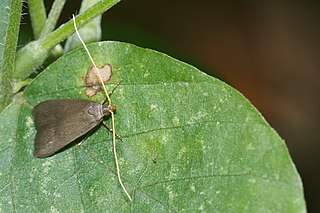
Urodidae, whose species are commonly known as false burnet moths, is a family of moths in the lepidopteran order. It is the type genus in the superfamily, Urodoidea, with three genera, one of which, Wockia, occurs in Europe.

The Lecithocerinae are a subfamily of small moths in the family Lecithoceridae. They are found worldwide, but most species occur in South Asia. The subfamily is characterized by the male genitalia with a bridge-like structure connecting the tegumen and the valva, and the uncus almost always is vestigial with two lobes at the dorsal base, only exceptionally united into a broad plate, but never as a thorn or spine.
Heteralcis is a genus of moths in the family Lecithoceridae. The genus was erected by Edward Meyrick in 1925.

Lecithocera is a genus of moths in the lecithocerid subfamily Lecithocerinae. The genus was erected by Gottlieb August Wilhelm Herrich-Schäffer in 1853.

Autosticha is a genus of gelechioid moths. It belongs to the subfamily Autostichinae, which is either placed in the concealer moth family (Oecophoridae), or in an expanded Autostichidae. It is the type genus of its subfamily. Originally, this genus was named Automola, but this name properly refers to a fly genus in family Richardiidae.
Dichomeris ceramoxantha is a moth in the family Gelechiidae. It was described by Edward Meyrick in 1929. It is found in Colombia.
Dichomeris explicata is a moth in the family Gelechiidae. It was described by Edward Meyrick in 1929. It is found on New Hanover Island in the Bismarck Archipelago of Papua New Guinea.
Dichomeris resignata is a moth in the family Gelechiidae. It was described by Edward Meyrick in 1929. It is found on the Bismarck Archipelago and the New Hebrides in the South Pacific Ocean.
Dichomeris melanortha is a moth in the family Gelechiidae. It was described by Edward Meyrick in 1929. It is found in southern India.
Dichomeris illicita is a moth in the family Gelechiidae. It was described by Edward Meyrick in 1929. It is found in Assam, India.
Dichomeris opsorrhoa is a moth in the family Gelechiidae. It was described by Edward Meyrick in 1929. It is found in South Africa.
Bagdadia cymoptila is a moth in the family Gelechiidae. It was described by Edward Meyrick in 1929. It is found in southern India.
Hypatima binummulata is a moth in the family Gelechiidae. It was described by Edward Meyrick in 1929. It is found in KwaZulu-Natal, South Africa.
Hypatima isopogon is a moth in the family Gelechiidae. It was described by Edward Meyrick in 1929. It is found in southern India.
Battaristis rhythmodes is a moth of the family Gelechiidae. It was described by Edward Meyrick in 1929. It is found in Pará, Brazil.
Heteralcis holocona is a moth in the family Lecithoceridae. It was described by Edward Meyrick in 1908. It is found in Sri Lanka.
Heteralcis isochra is a moth in the family Lecithoceridae. It was described by Edward Meyrick in 1908. It is found in Assam, India. and Sri Lanka.
Heteralcis molybdantha is a moth in the family Lecithoceridae. It was described by Edward Meyrick in 1908. It is found in Sri Lanka.
Heteralcis rhizophora is a moth in the family Lecithoceridae. It was described by Edward Meyrick in 1919. It is found in Chennai, India.



